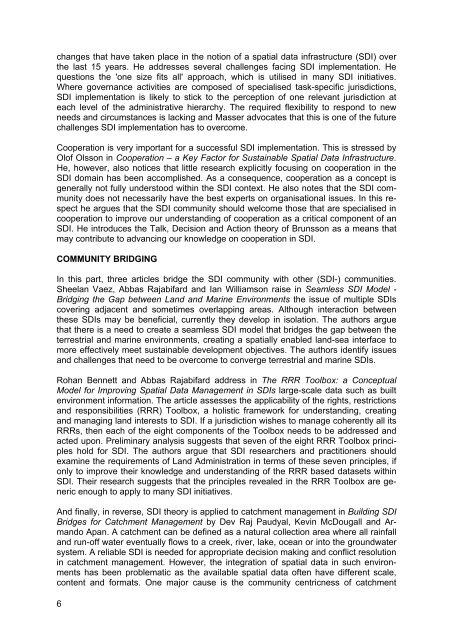SDI Convergence - Global Spatial Data Infrastructure Association
SDI Convergence - Global Spatial Data Infrastructure Association
SDI Convergence - Global Spatial Data Infrastructure Association
Create successful ePaper yourself
Turn your PDF publications into a flip-book with our unique Google optimized e-Paper software.
changes that have taken place in the notion of a spatial data infrastructure (<strong>SDI</strong>) over<br />
the last 15 years. He addresses several challenges facing <strong>SDI</strong> implementation. He<br />
questions the 'one size fits all' approach, which is utilised in many <strong>SDI</strong> initiatives.<br />
Where governance activities are composed of specialised task-specific jurisdictions,<br />
<strong>SDI</strong> implementation is likely to stick to the perception of one relevant jurisdiction at<br />
each level of the administrative hierarchy. The required flexibility to respond to new<br />
needs and circumstances is lacking and Masser advocates that this is one of the future<br />
challenges <strong>SDI</strong> implementation has to overcome.<br />
Cooperation is very important for a successful <strong>SDI</strong> implementation. This is stressed by<br />
Olof Olsson in Cooperation – a Key Factor for Sustainable <strong>Spatial</strong> <strong>Data</strong> <strong>Infrastructure</strong>.<br />
He, however, also notices that little research explicitly focusing on cooperation in the<br />
<strong>SDI</strong> domain has been accomplished. As a consequence, cooperation as a concept is<br />
generally not fully understood within the <strong>SDI</strong> context. He also notes that the <strong>SDI</strong> community<br />
does not necessarily have the best experts on organisational issues. In this respect<br />
he argues that the <strong>SDI</strong> community should welcome those that are specialised in<br />
cooperation to improve our understanding of cooperation as a critical component of an<br />
<strong>SDI</strong>. He introduces the Talk, Decision and Action theory of Brunsson as a means that<br />
may contribute to advancing our knowledge on cooperation in <strong>SDI</strong>.<br />
COMMUNITY BRIDGING<br />
In this part, three articles bridge the <strong>SDI</strong> community with other (<strong>SDI</strong>-) communities.<br />
Sheelan Vaez, Abbas Rajabifard and Ian Williamson raise in Seamless <strong>SDI</strong> Model -<br />
Bridging the Gap between Land and Marine Environments the issue of multiple <strong>SDI</strong>s<br />
covering adjacent and sometimes overlapping areas. Although interaction between<br />
these <strong>SDI</strong>s may be beneficial, currently they develop in isolation. The authors argue<br />
that there is a need to create a seamless <strong>SDI</strong> model that bridges the gap between the<br />
terrestrial and marine environments, creating a spatially enabled land-sea interface to<br />
more effectively meet sustainable development objectives. The authors identify issues<br />
and challenges that need to be overcome to converge terrestrial and marine <strong>SDI</strong>s.<br />
Rohan Bennett and Abbas Rajabifard address in The RRR Toolbox: a Conceptual<br />
Model for Improving <strong>Spatial</strong> <strong>Data</strong> Management in <strong>SDI</strong>s large-scale data such as built<br />
environment information. The article assesses the applicability of the rights, restrictions<br />
and responsibilities (RRR) Toolbox, a holistic framework for understanding, creating<br />
and managing land interests to <strong>SDI</strong>. If a jurisdiction wishes to manage coherently all its<br />
RRRs, then each of the eight components of the Toolbox needs to be addressed and<br />
acted upon. Preliminary analysis suggests that seven of the eight RRR Toolbox principles<br />
hold for <strong>SDI</strong>. The authors argue that <strong>SDI</strong> researchers and practitioners should<br />
examine the requirements of Land Administration in terms of these seven principles, if<br />
only to improve their knowledge and understanding of the RRR based datasets within<br />
<strong>SDI</strong>. Their research suggests that the principles revealed in the RRR Toolbox are generic<br />
enough to apply to many <strong>SDI</strong> initiatives.<br />
And finally, in reverse, <strong>SDI</strong> theory is applied to catchment management in Building <strong>SDI</strong><br />
Bridges for Catchment Management by Dev Raj Paudyal, Kevin McDougall and Armando<br />
Apan. A catchment can be defined as a natural collection area where all rainfall<br />
and run-off water eventually flows to a creek, river, lake, ocean or into the groundwater<br />
system. A reliable <strong>SDI</strong> is needed for appropriate decision making and conflict resolution<br />
in catchment management. However, the integration of spatial data in such environments<br />
has been problematic as the available spatial data often have different scale,<br />
content and formats. One major cause is the community centricness of catchment<br />
6

















